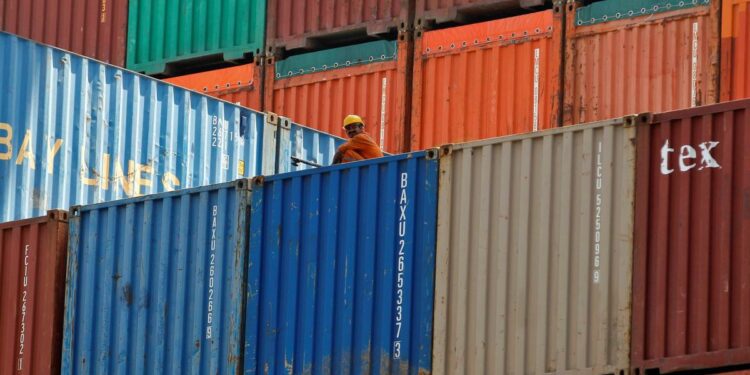Over the past 25 years, the United States and India have deepened their cooperation, transforming a relationship that was once defined by estrangement and tension. The two countries were at odds for much of the twentieth century, with a statist, protectionist India wary of Washington’s free-market agenda and the United States suspicious that India’s professed nonalignment veiled deep ties to the Soviet Union. But much has changed since the end of the Cold War and India’s subsequent embrace of economic liberalization in 1991. The partnership between India and the United States has grown increasingly close, from an important civil nuclear deal struck in 2005 to the two countries’ involvement today in the Quadrilateral Security Dialogue, a security partnership focused on the Indo-Pacific.
When it comes to trade, however, the countries’ cooperation has lagged far behind. U.S.-Indian trade ties remain superficial compared with the sophisticated economic links that the United States has built with other major democracies such as Japan, Mexico, and the United Kingdom, as well as the panoply of free trade agreements that India has recently inked with other new partners. In fact, key fundamentals of the U.S.-Indian trade relationship have changed very little since both countries joined the World Trade Organization as founding members, in 1995—and some have deteriorated. In 2019, for example, the Office of the U.S. Trade Representative ended India’s zero-tariff access to the U.S. market, stating in a press release that New Delhi had “implemented a wide array of trade barriers that create serious negative effects on United States commerce.” If that salvo was intended to force New Delhi to allow U.S. companies easier access to the Indian market, it failed: U.S. exports to India continue to face some of the steepest tariffs in the world.
The fact that the U.S.-Indian trade relationship remains cold is not altogether a surprise: it was on trade that the two countries’ strategies and philosophies diverged most strongly during the twentieth century. But the relationship no longer needs to be so frosty. Despite the obstacles imposed by both the U.S. and Indian governments, the volume of U.S.-Indian trade remains substantial, suggesting that the bilateral trading relationship’s underlying economic fundamentals are strong and ripe for expansion. After all, the United States was India’s largest trading partner for over 30 years, until last year, when it was overtaken by China. And over the past four years, Washington and New Delhi have made a few steps toward closer collaboration, dropping all of their outstanding WTO disputes, engaging in a series of high-level meetings on trade and technology, and collectively shaping the 2022 Indo-Pacific Economic Framework with a dozen other regional governments.
Even more important, however, both Indian and U.S. trade policies have undergone striking shifts that have brought them into much greater alignment. This alignment creates opportunities for more sustained and consequential cooperation between the two countries. Among those opportunities, none is more promising than the chance that the they have to jointly boost so-called green trade, or trade that supports resilient clean-energy supply chains and rewards low-carbon manufacturing. Cooperating on green trade initiatives would magnify the investments that both India and the United States are already making to decarbonize their economies. It would also develop more resilient and interdependent supply chains for clean technology products—setting a powerful and much-needed example for the rest of the world of how cooperative trade policy can help halt climate change.
COMMON THREAT
To veteran observers of trade policy, the proposition that India and the United States have much to agree on might seem outlandish. Throughout most of the history of the modern trade system, the two countries have been sharply at odds. From the 1947 establishment of the Global Agreement on Tariffs and Trade through the start of the twenty-first century, the United States was the world’s preeminent advocate for reducing barriers to the free movement of goods and capital across national borders and was the WTO’s leading champion. During this same period, India emerged as the de facto leader of a consortium of postcolonial developing countries reluctant to embrace trade liberalization. These countries worried that such liberalization would come at the expense of their newly gained sovereignty, undermine their efforts to address socioeconomic challenges such as food insecurity and poverty, and stunt fledgling domestic industries.
These divisions softened with the end of the Cold War and the rise of the Washington consensus, a paradigm that eliminated trade restrictions and reduced the role of the state in regulating markets, but they did not disappear. The only comprehensive global trade negotiations in the WTO era—the so-called Doha Development Round, which sought to lower tariffs and other trade barriers beyond the baseline established at the WTO’s founding—ended in failure in 2015 because differences between poorer countries led by India and wealthy countries could not be bridged.
But over the past decade, both countries’ trade policies have begun to converge on key issues such as the importance of developing bilateral and plurilateral trade relationships and the use of trade as a tool of industrial policy. Chief among the convergences is a deepening conviction in both Washington and New Delhi that China’s economic rise and its role in global trade—in particular, its dominant position in global supply chains—poses a national security threat and a challenge to other countries’ efforts to develop economically.
Both India and the United States have long viewed China as a rival or even an antagonist, but until recently this sense of competition was limited to national security. Washington and New Delhi generally welcomed economic cooperation with Beijing following the opening of Chinese markets in the 1990s. This traditional distinction between security and economic policy has eroded, however, as both U.S. and Indian policymakers have come to view geopolitical rivalry through an economic lens—and, by extension, to view Chinese mercantilism and persistent trade surpluses as evidence that Beijing intends to weaponize trade in the service of its hegemonic ambitions.
It is no accident that India and the United States now impose some of the world’s most aggressive tariffs and import restrictions on Chinese goods. Since 2014, India has opened nearly 150 investigations into unfair Chinese trade practices, compared with 34 against South Korea and seven against the United States. U.S. Presidents Donald Trump and Joe Biden, meanwhile, have levied a series of increasingly steep tariffs against an expanding list of Chinese companies on novel national and economic security rationales. Both India and the United States have also prioritized “de-risking” their supply chains to limit exposure to Chinese coercion and malign activities.
COUPLED RHYTHM
Beyond their approaches to China, both countries have sought to revitalize industrial policy. Industrial policy had been a foundational element of India’s statecraft from the country’s earliest days. But since 1991, when a currency crisis prompted far-reaching reforms aimed at economic liberalization, Indian authorities have progressively dialed back their attempts to insulate domestic manufacturing from market forces. As it did in many economies, this liberalizing approach contributed to a decline in domestic manufacturing and a rise in imports of finished goods, especially from China. Partly to curb the offshoring of production and partly out of a recognition that India remains under-industrialized relative to its potential, Prime Minister Narendra Modi launched the “Make in India” campaign in 2014, aimed at attracting more investment, encouraging greater domestic consumption of Indian-made goods, bolstering energy security, and positioning India as a global manufacturing hub. Since 2020, India has introduced incentive schemes to boost manufacturing in 14 sectors, including solar photovoltaic modules and advanced batteries.
Likewise, the United States has made industrial policy a focus since the COVID-19 pandemic, reversing a decades-long trend toward more limited state involvement in the manufacturing sector. Through landmark legislation such as the CHIPS and Science Act and the Inflation Reduction Act (IRA), both signed into law in 2022, the United States has allocated hundreds of billions of dollars to developing onshore and friend-shore supply chains in sectors such as transportation, energy, and semiconductors and encouraging investment in renewable power, green hydrogen, and electric vehicles.
Both India and the United States have used trade tools to implement and reinforce their industrial policies. The Make in India program raised tariffs on sectors targeted for development such as electronics and offered financial incentives that reward domestic manufacturing and import substitution in sectors such as textiles, solar panels, and medical devices. Similarly, the IRA limited its electric-vehicle tax credits to exporters in countries with which the United States has free trade agreements. Both countries have also sought to enhance their access to key supply chain inputs by establishing new trade relationships, such as the India-Australia Economic Cooperation and Trade Agreement, which lowered Indian tariffs on Australian lithium, and the U.S.-Japan Critical Minerals Agreement, which made goods manufactured in Japan eligible for tax credits under the 2022 Inflation Reduction Act and reduced barriers to trade in critical minerals between the two countries. India was also the first country outside the G-7 to join the U.S.-led Minerals Security Partnership, an association to spur public and private investment in stabler supply chains for critical minerals.
Due, in part, to a heightened focus on China and on industrial development, the United States is abandoning its historical role as the leading proponent of trade opening, and India is abandoning its role as liberalization’s preeminent critic. Among major economies, India was long one of the most reluctant to seek free trade agreements, and what trade diplomacy it did undertake was focused on regional partners and other developing countries. Over the past two years, however, New Delhi has gone on a signing spree, inking free trade agreements with more than a dozen partners around the world, including wealthy Western economies. The United States has made a pivot in the other direction, taking a more cautious approach to market access that favors narrowly scoped sectoral agreements focused on specific commodities and partnerships that do not involve tariffs but instead seek to strengthen supply chains and promote overseas investment. It has also grown far more assertive in its use of trade barriers. Both countries are shedding their ideological commitments around trade, seeing it more pragmatically as a vehicle for national development rather than as emblematic of their philosophies about the international order.
GREEN LIGHT
The increased political tensions around trade policy in the United States means that the odds of Washington and New Delhi inking a full free trade agreement are, in the near term, close to zero. Looking beyond free trade agreements, however, the opportunities to cooperate on trade are abundant. And seizing them is, in fact, vital to both countries’ economic security and growth.
Cooperation on green trade stands out, in particular, for its potential to strengthen both countries’ national security and boost their economic growth. India and the United States have each made a strategic bet that clean energy technologies—broadly defined to include solar, wind, and nuclear power, electric vehicles, and batteries—will be a major driver of economic growth and job creation in the twenty-first century. Each country is also seeking to develop a competitive edge in low-carbon manufacturing by investing in industrial decarbonization pathways such as green hydrogen, green steel, and carbon capture. Furthermore, both New Delhi and Washington have concluded that China’s dominance of the clean energy sector would pose a major threat to their industrial policy goals. Their approaches to de-risking have so far relied on supporting domestic industry. But both countries are facing the fact that they lack sufficient domestic resources to meet their energy security needs and are struggling to develop new supply chains to fill the gap.
Each country, in fact, has something the other needs when it comes to the green energy transition—above all a new market for current and emerging clean energy technology and services and a new partner in developing diversified supply chains for critical minerals. The United States and India have taken a few steps to move green trade to the center of their trade relationship, stressing the exchange of advanced technologies in diplomatic engagements. But much more can be done to reorient U.S.-Indian trade cooperation around building dynamic and secure net-zero industries. Cooperating more substantially on green trade would support both the United States’ and India’s industrial policies by strengthening supply chains, stimulating innovation, and broadening export opportunities in specific sectors that the IRA and the Make in India initiative already prioritize. It would also mitigate both countries’ concerns about China’s unfair trade practices, excess capacity, and economic coercion by diversifying access to the raw materials, industrial inputs, and finished products for which China has or is seeking a dominant market position. In addition, the narrow scope of green trade lends itself to tailored, creative trade cooperation of the kind currently pursued by both Washington and New Delhi: the range of goods and services relevant to green trade are a small subset of those covered in most free trade agreements and avoid some of the most contentious issues in the U.S.-Indian trade relationship.
A U.S.-Indian green trade agenda could be expanded to include other countries.
In one sense, collaborating on green trade looks like an easy, open goal for India and the United States. But the long history of U.S.-Indian trade friction and the mainstreaming of trade skepticism in U.S. politics will also make it a delicate process, favoring a gradual, incremental approach. As a trust-building first step, New Delhi and, in particular, Washington should seek stronger forms of the kind of soft cooperation at the heart of recent U.S. trade diplomacy, which eschews lowering tariffs and paring back regulations in favor of streamlining customs processes, harmonizing product and performance standards, increasing supply chain transparency, and developing systems for measuring the embedded carbon of traded goods.
From there, negotiators could explore creating narrowly scoped agreements aimed at enhancing each country’s energy security and industrial policy. The U.S. Trade Representative and the Indian Ministry of Commerce and Industry could ink an agreement endorsing subsidies for clean energy industries, something that current trade rules generally do not allow. To make such subsidies more palatable to both countries, the agreement could also promote joint investments in each other’s markets and clean tech industries. This kind of agreement has precedent: India and the European Free Trade Association (comprising Iceland, Liechtenstein, Norway, and Switzerland) already established a similar arrangement earlier this year, establishing a trade and economic partnership that provided for European investments into India of around $100 billion. Or India and the United States could pursue a market-access arrangement focused on a specific set of goods and services related to clean energy or low-carbon manufacturing—similar to the arrangement that the United States and European Union have been pursuing to create a protected market for low-carbon steel and aluminum.
The two countries could also jointly focus on promoting next-generation climate technologies, for instance by creating a public procurement process to stabilize the market, establishing compulsory licensing arrangements to facilitate technology transfers, and enhancing market access for each other’s exports. Finally, both India and the United States would also benefit from constructive, closed-door discussions about how to calculate and regulate embedded carbon in traded goods, given the strong opposition that India has voiced to the EU’s new Carbon Border Adjustment Mechanism and the bipartisan interest in a carbon tariff in the United States. Cooperating on green trade and coordinating more thoroughly on green industrial policy could help India plan for potential U.S. carbon tariffs and avoid the controversy that has afflicted the EU’s approach to this issue.
A gentle start to cooperation on green trade would be immensely valuable. Even limited partnerships are likely to demonstrate to both Washington and New Delhi the new ways in which they are aligned, setting the stage for deeper cooperation. And beyond their benefits to the bilateral relationship, new forms of green trade collaboration between the United States and India can serve as a blueprint. Elements of a U.S.-Indian green trade agenda could be expanded to include other countries or even adopted in a multilateral setting. As the influence of global trade rules and institutions wanes and climate-related trade measures proposed by the West are attracting fierce criticism from the global South, expanded green trade cooperation between New Delhi and Washington would send a strong message that developed and developing countries can work together to prosper.
Loading…
Source link : http://www.bing.com/news/apiclick.aspx?ref=FexRss&aid=&tid=66d9cea5a441466e8776a99e8e952843&url=https%3A%2F%2Fwww.foreignaffairs.com%2Funited-states%2Famerica-and-indias-green-trade-opportunity&c=3532853590423921786&mkt=en-us
Author :
Publish date : 2024-09-05 03:35:00
Copyright for syndicated content belongs to the linked Source.





